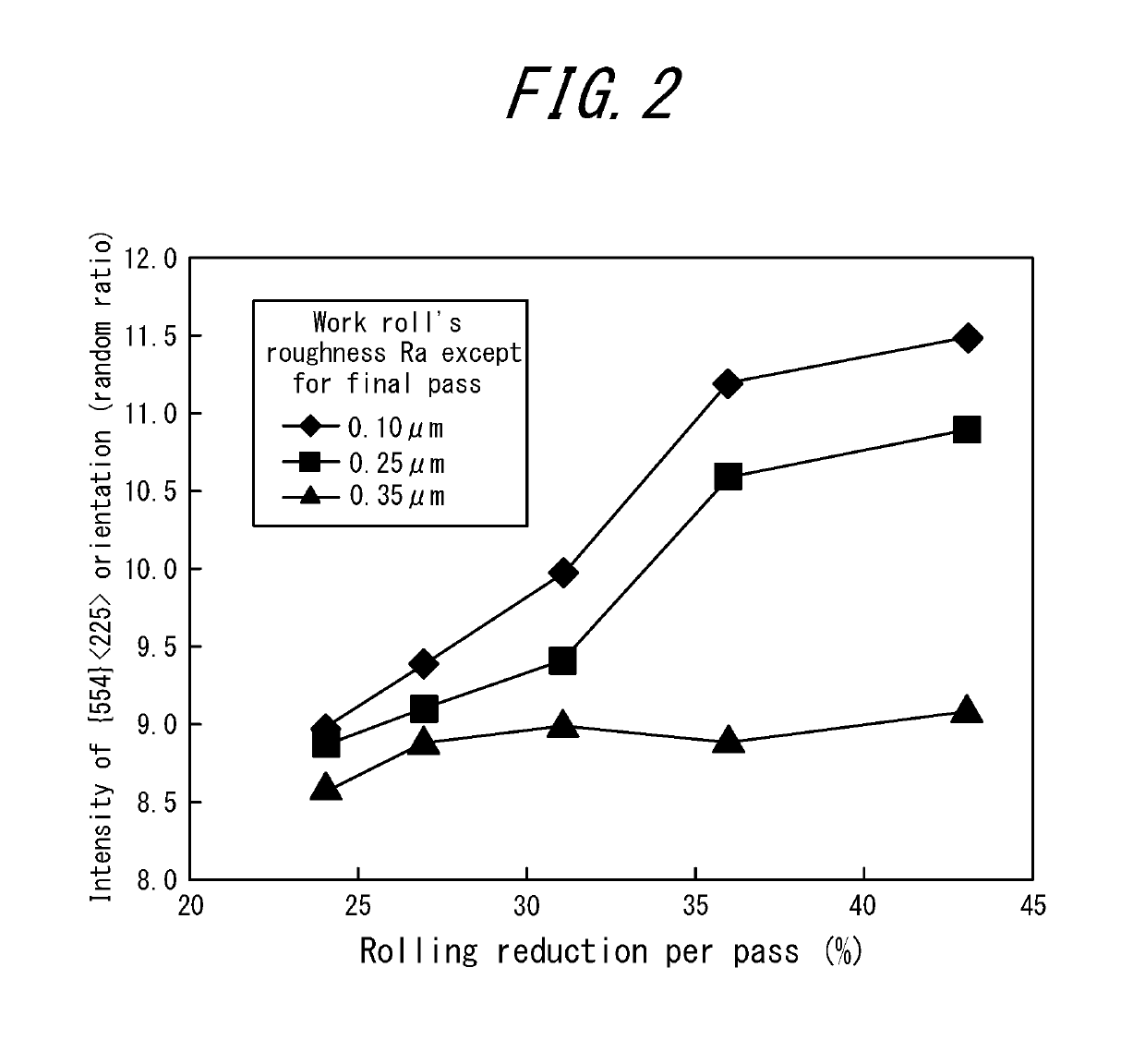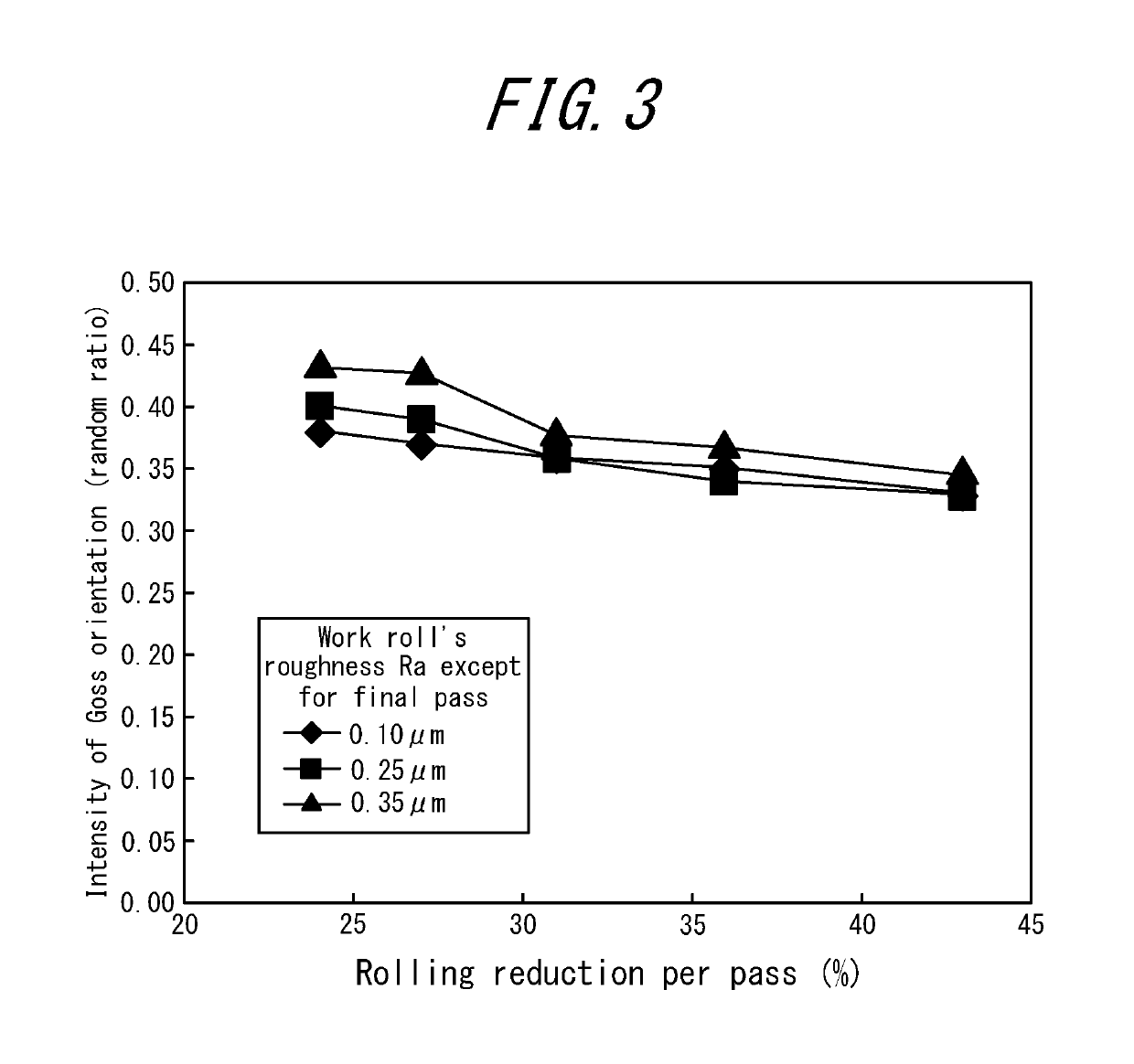Method for manufacturing grain-oriented electrical steel sheet
- Summary
- Abstract
- Description
- Claims
- Application Information
AI Technical Summary
Benefits of technology
Problems solved by technology
Method used
Image
Examples
example 1
[0122]Continuously cast slabs, each having a composition containing C: 0.03%, Si: 3.5%, Mn: 0.08%, sol.Al: 75 ppm, N: 45 ppm, S: 30 ppm, Se: 1 ppm, O: 9 ppm, P: 0.06%, and Cu: 0.10, and the balance consisting of Fe and incidental impurities, were reheated to 1200° C., and hot rolled into hot rolled sheets having a sheet thickness of 2.5 mm. The hot rolled sheets were then subjected to hot band annealing at 1050° C. for 30 seconds. Then, the temperature of both widthwise edges of each hot rolled sheet was raised to 200° C. by induction heating prior to the final cold rolling. After that, the hot rolled sheets were respectively cold rolled into cold rolled sheets having a sheet thickness of 0.26 mm under the conditions presented in Table 3. Subsequently, decarburization annealing was carried out under a set of conditions of heating rate=20° C. / s in a temperature range from 500° C. to 700° C., subsequent soaking=850° C. for 120 s, in an atmosphere of 55% H2: 45% N2 with a dew point of ...
example 2
[0129]Continuously cast slabs, each having a composition containing C: 0.025%, Si: 3.4%, Mn: 0.10%, sol.Al: 70 ppm, N: 42 ppm, S: 20 ppm, Se: 2 ppm, O: 30 ppm, P: 0.07%, and Cu: 0.08%, and the balance consisting of Fe and incidental impurities, were reheated to 1220° C., and hot rolled into hot rolled sheets having a sheet thickness of 2.2 mm. The hot rolled sheets were then subjected to hot band annealing at 1050° C. for 30 seconds. Then, the temperature of both widthwise edges of each hot rolled sheet was raised by induction heating as presented in Table 4 prior to the final cold rolling. After that, the hot rolled sheets were respectively cold rolled into cold rolled sheets in a tandem type mill. After the cold rolling, we examined the cold rolled sheets for edge cracks. The maximum edge crack depth is listed in Table 4.
[0130]Subsequently, decarburization annealing was carried out under a set of conditions of heating rate=as presented in Table 4 in a temperature range from 500° C...
example 3
[0136]Continuously cast slabs having different compositions presented in Table 5 were reheated to 1230° C., and hot rolled into hot rolled sheets having a sheet thickness of 2.2 mm. The hot rolled sheets were then subjected to hot band annealing at 1025° C. for 30 seconds. Then, the temperature of both widthwise edges of each hot rolled sheet was raised to 200° C. by induction heating prior to the final cold rolling. Subsequently, cold rolling was carried out in four passes using a tandem type mill under a set of conditions of rolling reduction per pass=44% and work roll's surface roughness Ra=0.10 μm, to thereby obtain cold rolled sheets having a sheet thickness of 0.22 mm. Samples were collected from the cold rolled sheets, and heated at a heating rate of 150° C. / s from 500° C. to 700° C. The samples were then subjected to decarburization annealing, where in the earlier part, they were retained at 840° C. for 100 s in an atmosphere of 55% H2: 45% N2 with a dew point of 55° C., and...
PUM
| Property | Measurement | Unit |
|---|---|---|
| Temperature | aaaaa | aaaaa |
| Temperature | aaaaa | aaaaa |
| Temperature | aaaaa | aaaaa |
Abstract
Description
Claims
Application Information
 Login to view more
Login to view more - R&D Engineer
- R&D Manager
- IP Professional
- Industry Leading Data Capabilities
- Powerful AI technology
- Patent DNA Extraction
Browse by: Latest US Patents, China's latest patents, Technical Efficacy Thesaurus, Application Domain, Technology Topic.
© 2024 PatSnap. All rights reserved.Legal|Privacy policy|Modern Slavery Act Transparency Statement|Sitemap



